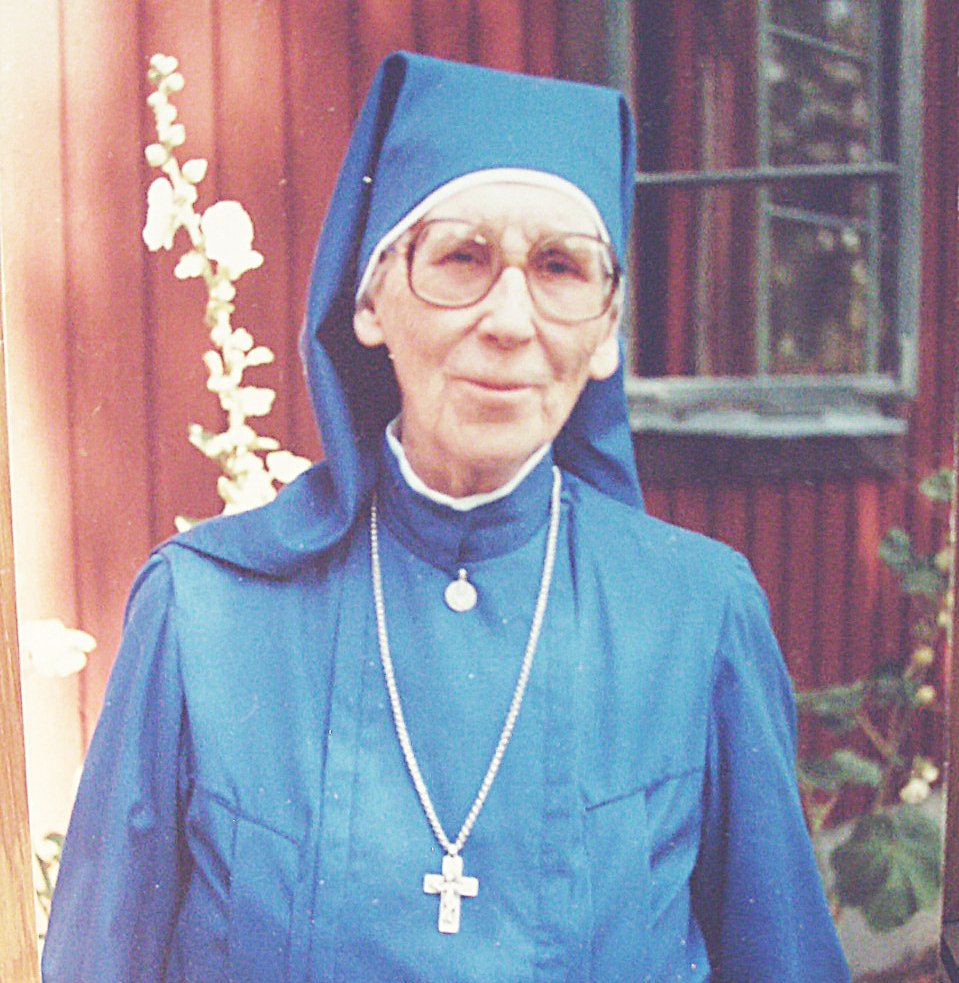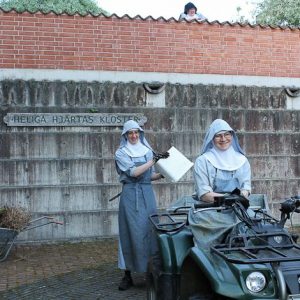Archive, Articles
Paulina Mariadotter: An Age of the Life of Love
In 1143, thirteen Cistercian monks from Bernard’s Clairvaux bade farewell to the vineyards of Burgundy and braved Swedish snowdrifts as they moved north to found the first Scandinavian abbey of white monks at Alvastra, thirty miles south of Vadstena. The community settled, prospered, and achieved some celebrity. Kings and nobles were buried under their roof, such as Ulf Gulmarsson, Saint Bridget’s husband, whose tomb from 1344 is still discernible in a side chapel among tufts of grass which have grown freely there since 1529 when, as part of the Swedish Reformation, the monastery was dissolved and largely destroyed. For four centuries Alvastra has been but a picturesque ruin, with cows grazing in its cloisters.
The seeds planted by Clairvaux, however, have lingered in the soil. In 1997, a community of Benedictine nuns restored monasticism to the region as they took possession of their new convent midway between Alvastra and Vadstena. Behind this foundation stands a remarkable Lutheran woman, Gunvor Norrman (1903-85), whose vision gave birth to religious communities in two churches, and whose life is emblematic of several burning issues facing western Christians as they move, whether with confidence or trepidation, into the third millennium.
Gunvor Norrman felt called to serve God from early childhood, yet spent several years as a consultant in domestic science before devoting herself exclusively to Christian social work in 1928, when she founded a residential home for young women offenders. Surrounded by broken lives, she saw that material security and professional training were not sufficient, on their own, to heal wounds inflicted by suffering and hopelessness. She sensed that the girls needed an entirely new foundation for their lives, a Way forward which could lastingly sustain weary wanderers.

During the 1930s, Gunvor’s search for such a Way became one with her personal vocation. The convergence occasioned great interior tension. She knew she had a task to fulfil, knew vaguely what it entailed, but found no way, within the Swedish church, of going about it. A guiding light appeared in 1937, when she discovered Frank Buchman’s Oxford Group and was thunderstruck by its absolute approach to Christian living. The encounter led to a conversion on uncompromising terms. ‘I have given God my life and my will. I can never again call my life my own’. In 1940, Gunvor left her job to be entirely free ‘to seek a Way’. Her own conversion had entailed an existential acknowledgement of her status as a sinner redeemed. Now she sought a mode of life which could facilitate that liberating process in others. For a while she felt drawn towards Catholicism, with its established forms of religious life, but she rejected the attraction as a temptation to ‘escape into security’. Her calling was to live precariously, trusting that the Way would somehow emerge.
Deeply conscious of Europe’s plight under the iron heel of Hitler, Gunvor began to dream of women with a vocation like her own giving their lives to Christ in communities of reconciliation, as resurrection witnesses on a crucified continent. At the end of the war she put that dream to the test by travelling south, to work as a peacemaker among refugees in the ravaged territories of northern Germany.
Her departure required a break with the Oxford Group, whose other members regarded her enterprise with incomprehension. She dreaded the prospect of isolation, until one day she sensed that, far from sowing division, ‘Christ was calling us to unity. I was given to see that there is a Heart, the Heart of Jesus, where there is space for all things and where each part serves the whole. And that Heart is alive and pulsating in each one of us.’
Gunvor had found a symbol for her christocentric vision of the church as a living organism whose diverse charisms flow from a single source. It gave her confidence to pursue her calling to set women free for God’s service, helping them to stake their lives on Christ’s victory over death. During the late 1940s, a small community gathered round her. The Way was now a reality. The time had come to discern where it would lead.
In a Germany marked by universal despondence, Gunvor had come to see that the reconciliation which lay at the heart of her mission was not an objective to be imposed from without, but an interior reality based on conversion. On a larger scale, she had re-lived her experience with the young offenders twenty years earlier. The most aching wounds of society are not cured by exterior measures. They require a healing transformation, the source of which is Christ’s resurrection.
Once more, she was faced with the absolute. Once more, she was uncertain how to respond. A number of women were looking to her for direction, but as she returned to Sweden in early 1949, she did not know where to lead them. The Lutheran church, suspicious of nuns, neither understood nor appreciated the kind of consecrated life they desired, and the Way seemed to be stuck in a cul-de-sac.
After weeks of overpowering darkness, a light blazed up one night in March. ‘Jesus Christ was there, present, and he gave me his Mother to be my Mother. She was a living promise and a probing challenge: Do you dare to believe in me, in my continuing mission? I could only answer with a prayer: Mother of God, pray for me.’ In a visitation that broke down every barrier, Gunvor’s ideal of ‘monasticism in the world’ received its approbation from the Mother of God. From then on, she and her sisters referred to themselves as Mariadöttrar—Daughters of Mary.
Based on ‘absolute faith in the saving work of Christ’ and ‘absolute faith in his resurrection’, Gunvor wanted the sisterhood to bear witness that ‘Jesus Christ has won the victory. He is risen indeed. It is no longer mere hope, it is reality and truth’. By rising from the dead, Christ has ushered in an age of perpetual Nativity as he takes flesh anew in one believer after another. The Marian Way should be a sign of that new life, ‘which cannot be preached to the world, but only lived from heart to heart’. It must be passed on like a flaming torch.
Half a century after Gunvor’s vision, the flame burns brightly in several communities of Lutheran sisters, and in the Catholic monastery of the Sacred Heart near Vadstena. The latter sprang from a group of Mariadöttrar who, having followed Benedict’s Rule since 1977, longed for sacramental fellowship with the wider Benedictine communion and converted in 1988. Gunvor, with her profound sense of the church as one Body with many members, rejoiced at this new opening for the Way.
Driven by a deep yearning for Christian unity, she had herself felt tempted to change denominations, yet she knew that the key problem ‘would not be resolved by my becoming a Catholic, or a Pentecostalist. In the freedom of God, I remain in the state in which I was called. There I depend on God alone.’ Her idea of ecumenism was of uncompromising fidelity to the gospel, at the heart of the one church which pulsates with the heartbeat of Christ. Her criteria were plain. Do you believe in Christ’s victory? Will you follow him wherever he goes?
Gunvor once summed up the Christian vocation as a calling ‘to live in profound reverence for every living thing, and to do our duty’. On similar terms, she referred to her sisterhood as a Workshop of Responsibility. In a world tired of talk, which has devaluated much Christian vocabulary to the point of rendering it meaningless, her emphasis seems prophetic. Western Christians can no longer pretend that their faith is woven into the fabric of society. They have no time to lose on introspective squabbles. They must assume responsibility for the life entrusted to them, and pass it on.
When Saint Bernard sent his brethren to Sweden eight and a half centuries ago, it was to implant the life of Christian perfection in a region located by contemporary Cistercian chronicles in extremis finibus mundi. Today, in those very parts, the ideal lives on through the legacy of a woman who dared, without a trace of irony, to hope for ‘an age of the life of love’. Her programme was simple: radical conversion. Her motto was the prayer of Christ: ‘May they all be one’.
That prayer is crucial to the Benedictine community of Daughters of Mary in Vadstena. As Catholic nuns with a Lutheran ancestry, vowed to conversion and reconciliation on the soil of Saint Bridget, a newly proclaimed patron of Europe, their thriving monastery might be a sign to the western church on the threshold of the third millennium. Its very existence is a paradox. But perhaps time has come to expect the unexpected. Surrounded by a self-destructive culture terrified of death, western Christians must, as Gunvor Norrman saw, face essentials. Do they believe in Christ’s resurrection? If the answer is yes, who knows what might happen.

